By Stephanie Taylor
Editor’s note: Thanks to some terrific input from the AFOL community, it’s been brought to our attention that some of the data presented here may be incomplete. We’re reviewing that data and will change as needed, and then republish.
In mid 2018, for the 40th anniversary of their iconic minifigure, LEGO released a timeline of minifigures over the years.
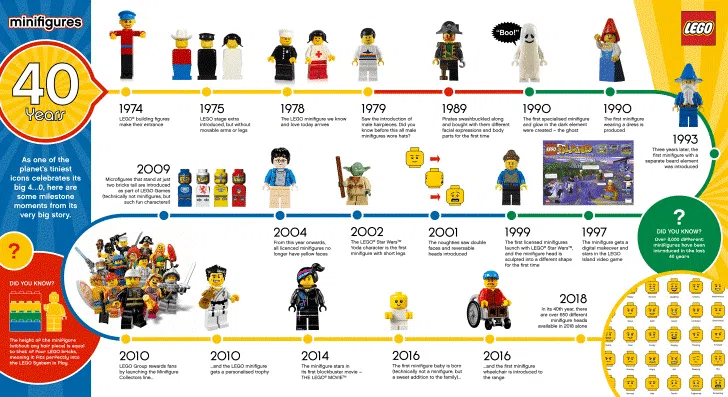
This timeline, while interesting and informative, fails to make mention of many important steps in the LEGO character timeline, particularly in regards to female characters. Major exclusions are the introduction of female specific heads, heads in colors other than the classic yellow, and the launch of minidolls (most notably the Friends line). Because of the gaps in the timeline, we took it upon ourselves to document the chronology of specifically female marked heads and characters from their inception (1978) to the end of May 2020, when the data was collected (the timeline does not include June 2020 releases). Our findings are detailed below.
General Findings
The following data was collected primarily from Brickset.com and Bricklink.com. We have included the full timeline at the bottom of this article, though the timeline can be broken down into four parts.
The timeline begins in 1978, with the first modern minifigure released. Although the first female figure was released in this year, it wasn’t until eleven years later that LEGO began production of a female coded head (1989). This head was coded as female through bright red lipstick and larger lips. This way of representing women (larger lips, generally exaggerated makeup) would become the norm for female coded heads. Later, as seen in 1992, LEGO began coding female heads with eyelashes and then, in 1997, adding eyebrows. Generally, as the years passed, LEGO used these three factors (make-up, eyelashes, expressive eyebrows) to signify female heads as opposed to their male or non-labeled counterparts.
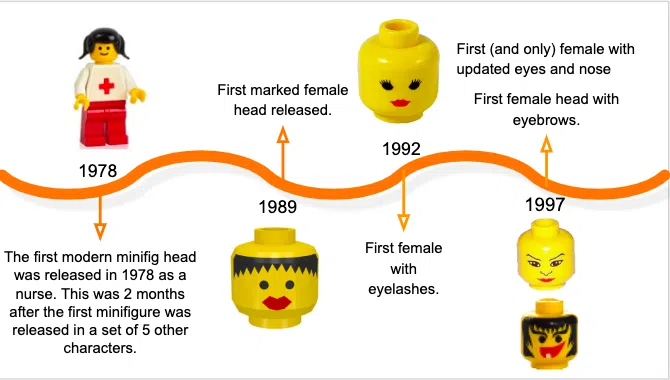
Also released in 1997 was the first and only female head with a nose and updated eyes. This is significant not only because of the updates to the face but because this female, although in the Yellow fleshtone, was the first coded as a person of color. Specifically, this head was part of a LEGO subtheme called “Indians”, which was part of the larger “Western” theme. In the Indian subtheme, each minifigure was supposed to represent a Native American person, often completed with facepaint, headdresses, and weapon accessories. LEGO discontinued this version of the subtheme almost as soon as they had begun to produce it, in 1997. It is unclear if this was due to backlash from the Native American community, because the sets were not selling well, or some combination of the two.
In 1998, LEGO released the first female specific head with headgear or a helmet in blue. This fig was included in several sets and was supposed to represent a robot. Interestingly, the small amount of face showing seems not to be in yellow. However, LEGO did not officially release fleshtones until 2003, with the introduction of both the Star Wars sets and the NBA sets. It is unclear why this head is an outlier here.
The next important steps in female minifigure head development came in 2001. In this year, the first female head modeled after a character was released (Hermione, the Harry Potter series), as well as the first female head with glasses, marking an important step in further diversity of female heads. However, to date, there are still very few female heads with glasses, even though more than 1.4 billion people wear glasses around the world.
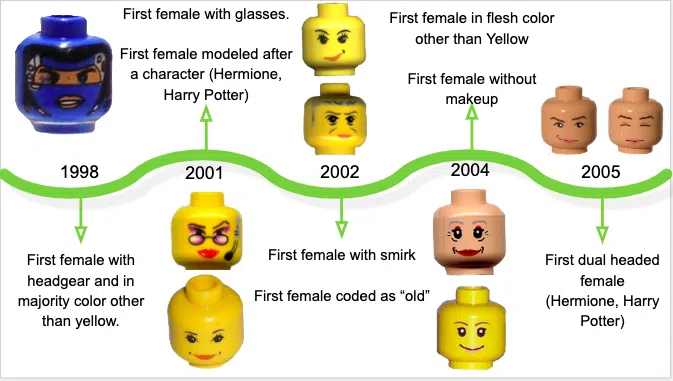
Also included in this timeline is the first female head pictured smirking (2002). Smirking, like makeup, would become a common occurrence among female heads, although very few male heads are ever pictured smirking. Also seen in 2002 is the first female head that was coded as elderly was released in 2002. To date, however, there are no older or elderly heads in any darker skin tone (including Medium Nougat, Reddish Brown, Medium Brown, Tan, Nougat, and Dark Orange), although there are multitude of older coded heads in both Yellow and Light Nougat. This is one example of LEGO struggling with being truly diverse in their minifigure heads. While they introduced fleshtones other than Yellow in 2003, and further released the first female coded head in a color other than Yellow in 2004 (Light Nougat), they still have yet to have a fully equitable range of heads in every available color, and this is shown partly by the example of older coded female heads.
Also in 2004, LEGO released the first female head without makeup, a full fifteen years after the release of female heads. This was an incredibly important step, and represented a recognition on LEGOs part that they could depict clearly female heads without any makeup.
A year later, LEGO began production on their first double-sided female head, which was, again, a representation of Hermione from the Harry Potter series.
In 2006, LEGO released the first female coded head without black and/or white eyes. This head was a representation of Katara from the TV show Avatar: the Last Airbender. Perhaps equally important was that this was the first female character that LEGO clearly white-washed – in the show, Katara is supposed to be Inuit, and has a significantly darker skin than the way she is portrayed in LEGO form. Again, this is several years after LEGO introduced fleshtones other than Yellow and Light Nougat, however at this point, all of the minifigures in other fleshtones were male.
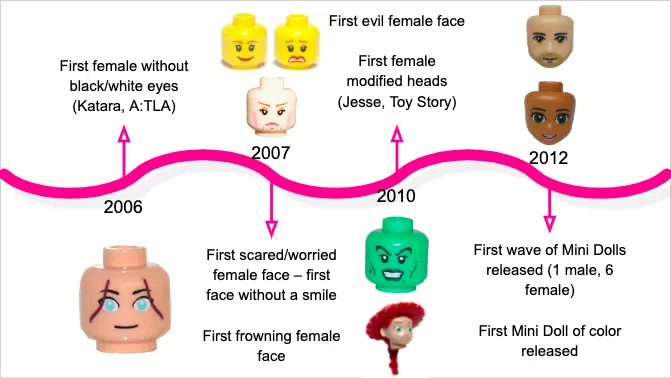
2007 marked the first year that LEGO released several female heads that were not smiling – one that was scared, and then several months later, one that was frowning. This beginning of range of expression in female heads meant that LEGO was starting to more fully represent the female population. However, it is also important to note that these heads were only in Light Nougat and Yellow.
In 2010, LEGO released the first evil female face, in green. Particularly interesting here is that LEGO produced an evil female minifigure face before they produced a female face in a fleshtone other than Yellow or Light Nougat.
The timeline also includes important modified female heads (the first being in 2010) as well as the introduction of the minidolls series in 2012. Minidolls are a particularly important but equally under-represented entity in the original timeline. Not only are minidolls nearly all female coded (the opposite is true in minifigures), but they are far more ethnically diverse than minifigures on a whole (especially after the 2018 reboot), so it was especially important to include the minidolls in our timeline. Indeed, the first minidoll of color was released in at the same time as the other minidolls in lighter fleshtones. Interestingly, the first female character of color that LEGO produced was not the classic minifigure, but that brand new minidoll in 2012.
The first female head of color wasn’t introduced until 2013, ten years after LEGO introduced skin tones other than Light Nougat and Yellow in 2003. This character was an alien, however, so it was in 2014 that there was a human female POC face. Furthermore, while the first female without makeup (Yellow skin tone) was introduced in 2004, it wasn’t until 2016 that LEGO released a similar head in a darker skin tone, making it nearly thirty years before women of color were given a head that naturally represented them. Perhaps even more problematically, it wasn’t until 2017 that there was a WOC (woman of color) face that was not modeled after a character from a comic or book series. This face was in the Medium Nougat color, and it wasn’t until 2018 that a similar original face was released in Reddish Brown. But to date, there is no original head (not modeled after any character or person) in flesh tones other than Yellow and Light Nougat.
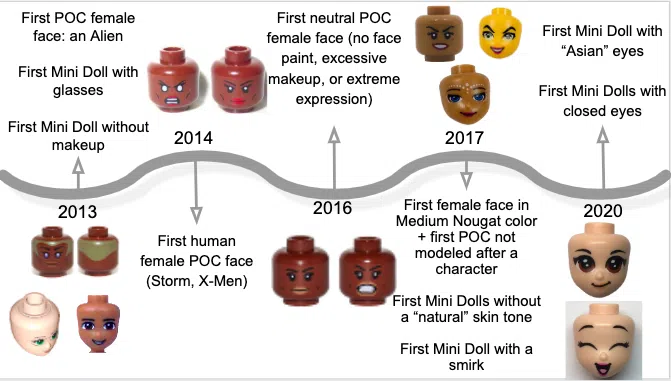
As represented by a further examination of the data, darker skin tones in female heads are still severely underrepresented, even considering all those modeled after characters. For example, to date, there are 2028 male minifigure heads, and 585 female minifigure heads released in total by LEGO. Of this female proportion, there are 249 Yellow female heads and 163 Light Nougat female heads. In comparison, there are 10 Dark Reddish female heads.
On the other hand, minidolls are surprisingly diverse when compared to their minifigure counterparts. As mentioned earlier, it took LEGO fifteen years to release a female head without makeup and another thirty years for a similar head to appear in darker fleshtones. In comparison, it only took one year from the release of minidolls for LEGO to produce one without makeup – and this was a character in a darker fleshtone. Similarly, while LEGO didn’t release a minifigure head with glasses until 2001, a minidoll with glasses was produced almost immediately after the introduction of minidolls (in 2013). And minidolls with smirks, such a standby in female minifigures, didn’t become available until mid 2020.
This is not to say that minidolls are without their issues. For example, in 2020, Bricklink (a third party created but now LEGO owned site) labeled a Mulan inspired minidoll as having “Asian eyes”. Similarly to the problematic “Indian” subtheme, this minidoll had significantly different eyes and facepaint than her other minidoll counterparts.
Conclusions
It seems clear from this data that LEGO prioritises male minifigures over female minifigures, and further gravitates towards young, non-WOC skin tones with make-up. LEGO thoroughly proves this through their 40 year anniversary timeline, which, as shown above, is woefully incomplete in several important areas. Although LEGO has made certain positive strides towards equality through their introduction of female heads of other fleshtones, minidolls, and heads without makeup, there are still some areas, especially within the female heads, that are woefully incomplete and biased against many minority groups. This suggests that LEGO does not value their female characters as much as their male and likely, by extension, their female contributors, including employees and WAFOLs (Women Adult Fans of LEGO). Thus, throughout this timeline, we are able to gain insight into what LEGO, as a company, prioritizes in their female heads and contributors.
Below please find the vertical representation of the female minifigure timeline.

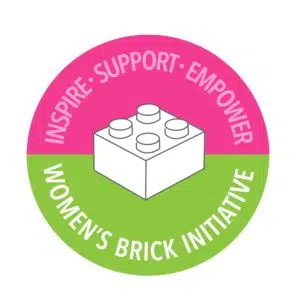

9 comments
Heather
I was hoping to see an inclusion of minifigs made for lego-made movies and TV series in the timeline–from the really early movies to Nya (and the other women) of Ninjago to the lovely gender-balanced Lego City Adventures. Feel like that’s quite an important lineup.
Håkan
Well, Lego’s official standpoint is that yellow is a neutral color not comparable to real human skin colors of various ethnicities. Although that standpoint has been criticized due to yellow being much closer to lighter natural skin colors than darker, it seems like a standpoint they won’t be ready to reverse anytime soon.
Ordinary minifig heads also have a highly simplified design overall, and the decision to have ethnically coded yellow heads (such as the native americans in the Indians theme, and the many coded black players in the Basketball theme) has also been criticized for being stereotypical and exaggerated.
The Asian characters from the Indiana Jones set (Short Round and the two gangsters) had quite exaggerated features, but newer Asian characters, such as Rose Tico and Cho Chang, have very subtle features, and the characters in the Chinese seasonal and Monkie Kid sets are likely meant to be Chinese, but are quite undistinguishable from general yellow-headed characters.
That leaves the option to code characters by ‘hair’, where a few characters in the City sets seem to be coded black by their hairstyles alone. As such, very subtle.
Claire
A very interesting article. Thank you for writing it and putting it out. I do have a couple of questions though.
Do you consider the minidolls to wear makeup? Olivia’s mother from 2012 definitely has makeup on, but I have never considered any of the girls to be wearing it.
This might just be my ignorance talking, so can you help me understand the problem with Mulan’s face? She looks fine to me. Very much like her cartoon version.
Suz
I too noticed inaccuracies in this chart but Dave has covered most of those in his own comment, so I will focus on this quote:
“This suggests that LEGO does not value their female characters as much as their male and likely, by extension, their female contributors, including employees and WAFOLs (Women Adult Fans of LEGO).”
This is *so* not true.
People seem to forget that LEGO is a company. LEGO makes what people buy. Or they go broke. This article ignores the repeated attempts by LEGO to gain valuable market share from the other half of the population. Your analysis, by focusing only in figure heads, omits those efforts. Homemaker, Scala, Paradisa, Belville, Friends(the first round in the 90’s), Scala AGAIN….? They tried and tried.
Believe me, this has always been important to them. But they can only afford to lose so much money trying to change the minds of consumers. To expect LEGO to develop, produce, and ship products that never get bought is unreasonable. To expect stores to stock products that customers don’t buy is laughable. And to accuse LEGO of not valuing their female customers or employees is rude. That was certainly not my experience working there AT ALL. Quite the opposite. And as a female fan, I have honestly been [noticeably, and sometimes embarrassingly] called upon more often than my male LUGmates to provide input to LEGO, making it clear that they value my unusual perspective enough to seek it out.
With richer analysis of the company history, you’ll notice diverse races, ages, and genders in the DUPLO line, going back 30 years. That’s because of the difference in shopper. Teachers and day-care providers choosing materials for their classrooms or centers recognized the great importance of figures that children could relate to. They were also sometimes shopping for a demographic that could not afford LEGO products (often POC, here in the US). If LEGO didn’t value females and POC, why would they make those wonderful DUPLO families, covering three generations and four races?
There’s often more to the story than people outside the toy industry realize. For example, to some extent, LEGO is at the mercy of buyers like WalMart in what they offer. If WalMart says, “put that in a pink box and we’ll buy it.” Or, “We want a new fire truck this year,” they kinda have to keep them happy. The buyers are the ones with the shelves. And at a Licensing Expo, what’s LEGO to do when most of the hot characters are male? That’s not their fault—and to their credit, they have created their own female properties.
If there’s blame to be handed out for a lack of diversity in LEGO figures, most belongs on the shopper, and on the society who influences them, and on the simple fact that LEGO is a quality product and thus expensive (too expensive for some portions of an unequal population). Basically, LEGO makes what the shoppers think their kids want. They are a company, after all. Please note that they also have philanthropic (see the LEGO Foundation) and Education divisions that would not exist without the profits from the mainstream toy market.
I’m sorry to rant like this, but I am just so tired of seeing this gripe thrown around. I’ve seen it for decades while LEGO continually takes risks, trying to do good. For example, they put obviously female garbage collectors and fire-fighters in sets years ago. I don’t even personally know any females doing those jobs in real life, and I’d bet many boys receiving the sets were not thrilled about it—but LEGO did it anyway. Please give them a break. Be happy that they just recolored all their robotics kits and adjusted programming to be more appealing to girls in their market testing. (Yay, STEM for all!) LEGO is not perfect, but they are always learning and I believe they push the market as much as it will practically bear. Thankfully, the consumer tide is moving in the right direction.
S AGOULD
Really liked your reply. Right now California is debating mandating genderless toy aisles, so I checked to see how Lego might be doing and ended up here. And since Mr/Mrs Potato Head who were modularly gender neutral anyway, I thought I’d see if LEGO would be brought into the conversation on that topic.
My view is that LEGO is in business to make money by pleasing their customers, and the marketplace influences this, not the government, who should be more concerned with climate crisis, not children’s toys anyway.
Though the Friends line never appealed to me, as an AFFOF for 40 years now, I am quite happy with the LEGO company progression: the spare parts programs, challenging/more artistic kits, more colors, and fan collaborations, such the Grand Piano.
The last Brickworld convention I attended had on Dad building a Rock Concert stage, and his daughter’s attending to every detail of the mining fans. There was also a woman who worked with NASA and had built an 18’ long detailed, accurate build of the transportation system that takes the Challenger Shuttle to the launch pad. It’s delightful watching the little girls (and boys) participate in the STEM Robotics competitions.
LEGO is very family friendly, you can do whatever you want with it. I can’t think of any other toy system with that flexibility and appeal.
David
So… there are a number of things to correct here:
(1) Not part of this article per se, but the site’s main page, apparently:
“In 1963 the LEGO company developed a set of guidelines”
That was actually developed in 1954, and was the basis for the development of the Town Plan in 1955.
(2) “The first modern minifig head was released in 1978 as a nurse”
I would correct that to “minifig” rather than “minifig head”. The minifig head was released earlier, in “stiffy” figs, which were also female specific, starting in 1975.
(3) “Major exclusions are […] the launch of minidolls”
Minidolls aren’t minifigs– I think you need to be clear about which figures you’re talking about, since LEGO has also had DUPLO figures, Scala figures, and even Town Plan figures (which featured females) in the 1950s. There’s also microfigures, Belville, Galidor, DUPLO Dolls, and probably more.
(4) “LEGO began coding female heads with eyelashes and then, in 1997, adding eyebrows.”
That’s true, although misleading. Red lips and eyelashes were almost or exclusively limited to female minifigures– they were indeed part of the “coding” for being female. But having eyebrows wasn’t limited to female minifigs, that was just when more minifigs started getting them.
(5) “LEGO discontinued [Indians] almost as soon as they had begun to produce [them], in 1997. It is unclear if this was due to backlash from the Native American community, because the sets were not selling well, or some combination of the two.”
That was common at the time. They stopped the whole Wild West theme (not just the Indians part) in 1997 as well. Aquaraiders, Divers, Fright Knights, UFO, Robo Force– all introduced in 1997, and sold for a couple years before being removed from the shelves. I doubt it was removed due to backlash. If you’ve got evidence to that effect, please share it– otherwise it’s just speculation.
Oh, and they also had a “stiffy” figure with red skin tone in 1977 in the set 215 Red Indians, much earlier. And Samsonite had models depicting black people (“Native Girl”) far earlier (brick built, not pre-fab figures).
(6) Omission: “Ann-Droid” was released in 1996, a supposedly female robot (although this was entirely due to the name rather than the design of the minifigure)
(7) “However, LEGO did not officially release fleshtones until 2003, with the introduction of both the Star Wars sets and the NBA sets.”
Star Wars was introduced in 1999, not 2003. Further, although Lando was introduced in a different skin tone in 2003, the rest of the “fleshy” figs in Star Wars didn’t really start until 2005. Star Wars was also the last theme to move to white pupils in the eyes in a similar timeframe– they continued to have solid black pupils for longer than other themes.
(8) “The next important steps in female minifigure head development came in 2001. In this year, the first female head modeled after a character was released”
The first licensed female minifigure was Padme (Star Wars), in 1999.
(9) “To date […] there are no older or elderly heads in any darker skin tone […]. This is one example of LEGO struggling with being truly diverse in their minifigure heads.
I’m not sure that’s really fair. Minifigures are typically only non-yellow in licensed lineups. They don’t often depict non-yellow figures in their own IP. Hence, that’s more of a fault with the licensed materials rather than with LEGO itself. That’s blaming LEGO for the fault of the media industry.
(10) “In 2010, LEGO released the first evil female face, in green.”
Willa the Witch from 1997 was intended to be evil– although admittedly a bit “silly evil”.
(11) “Similarly, while LEGO didn’t release a minifigure head with glasses until 2001”
Probably want to specify “female with glasses”, since male or gender-neutral heads with glasses were around before 2001.
“This suggests that LEGO does not value their female characters as much as their male”
… OK, I’m still with you.
“and likely, by extension, their female contributors, including employees and WAFOLs (Women Adult Fans of LEGO).”
WOW.
The data you presented in NO WAY supports that conclusion. Their product lines represent problems in culture demographics of their CONSUMERS and their MARKETING, but in no way is indicative of how they view their employees or their fans.
If you want to make that conclusion, you would need to talk about how their business works, and how women employed by LEGO feel in the workplace, as well as how female AFOLs feel they’ve been valued by the company based on their interactions.
In fact, if you look at their OTHER product lines, including minidoll lines (which you mention) and DUPLO (not to mention Scala, Belville, and others), you’ll find a totally different picture. Check out DUPLO figure diversity in the 1990s, for instance.
The fact that the LEGO Company was dealing with diversity totally differently in other product lines clearly demonstrates that the representation in their products has no bearing on how they view their fans or employees.
From what I know of the LEGO company, your assertion that they value female employees or fans less is… well, insulting. If that’s the conclusion you’re aiming for, you need to do your research and prove your case, not just speculate. Everything that I’ve heard runs contrary to your assumption.
“Thus, throughout this timeline, we are able to gain insight into what LEGO, as a company, prioritizes in their female heads and contributors.”
LEGO values its male characters more because that’s the market that they’ve figured out how to corner for 40+ years: boys age 5-12. They figured that out really early, but continued to be baffled by girls in the same age range. And that’s not just LEGO– that’s the construction toy industry as a whole.
LEGO’s careful attention to HOW girls played with construction toys during development of the Friends lineup was hugely innovative. It’s just a shame that nobody worked that out back in the 1970s when they introduced minifigs.
S A GOULD
Liked your reply. but as an AFFOFs, my objection to the Friends line is the physically crippled figures: fused legs and arms/wrists, and as such could not be animated like the classic minifigs. And girls also love horses, but they have to stand up on them rather than ride.
Benjamin
Hey!
First of all a great article with clearly a lot of time that has been spent in researching and analysing the topic.
It’s great to see some more academic and analytic ways of exploring the LEGO medium.
When it comes to “real” skin colours that should represent real living humans TLG almost exclusively use them for licensed themes as Star Wars or Harry Potter. Therefore a lack of WOC in this series is actually problem that goes beyond the TLG production but into our culture that is neglecting active roles of WOC in our pop culture. And when we have them, there is a lot of rage by white supremacist like we had in the new Star Wars movies.
So maybe TLG should concentrate on other topics than all those so well-known pop cultural movie and games production. But here’s the problem that TLG is a business that wants to make money. And sadly something like Star Wars and Harry Potter is a best-seller in contrary to most other productions that highlight the roles of WOC.
The other option is of course how you suppose it to replace yellow minifigs with diverse skin colours. I guarantee TLG won’t do that but I appreciate your task.
Also I think when it comes to female coded minifigures that they are not just underrepresented especially when it comes to women of colours but also mostly playing side-roles for the male characters. When researching this topic it is really important to look on the role the female coded minifigs play in the set or even the whole theme. I bet you are doing something in that way for the future and I am really looking forward.
For myself I try to use the potential that the LEGO medium has to engage people with history while at the same time reflect what narratives TLG and the community are actually showing. For that I have written an article a while ago where I shortly focus on the topic of gender in historical settings. You might want to have a look on it for your future articles.
I can say that I enjoied reading the article and I’m looking for more of you in the future